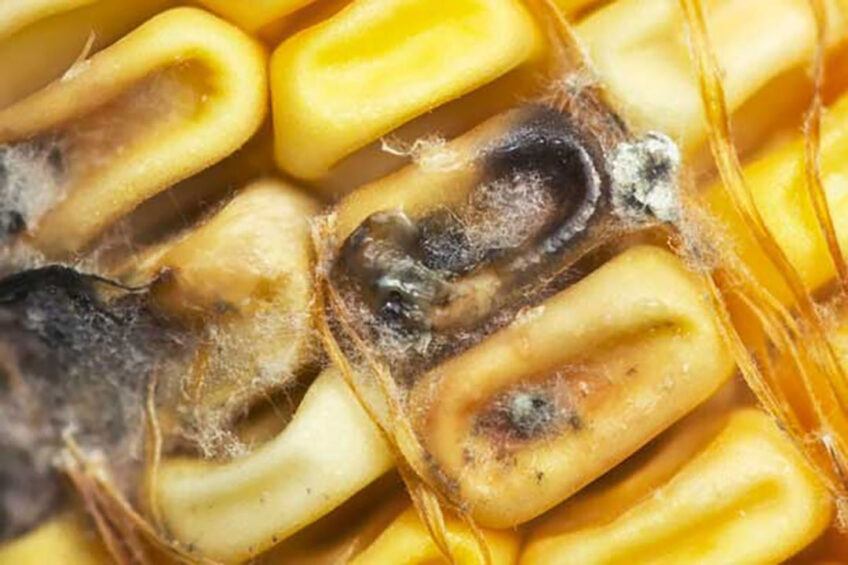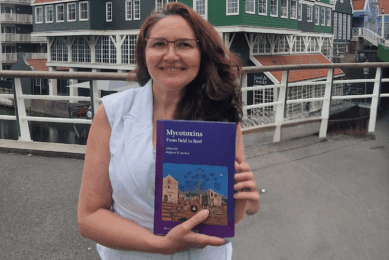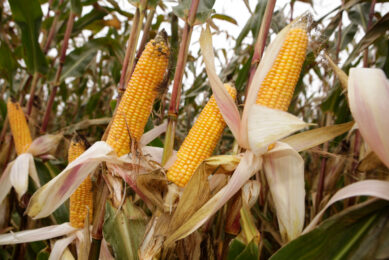Detoxification approaches for mycotoxin contamination in livestock feed

Mycotoxins affect animal health, performance, and the quality and safety of products; therefore, it is essential to find efficient methods for mycotoxin control in feedstuffs. This article will discuss various physical, chemical, and biological approaches developed for the detoxification of mycotoxins in livestock feed.
Mycotoxins are secondary metabolites of various species of fungi causing chronic or acute toxicity in livestock. Aflatoxin, deoxynivalenol, zearalenone, and fumonisin are the main mycotoxins contaminating feedstuffs, such as corn, barley, wheat, peanuts, peas, nuts, millet, forage, and their by-products. Aflatoxin, mainly produced by Aspergillus, displays hepatotoxic, immunotoxic, mutagenic, carcinogenic, and teratogenic characteristics in many animal species. Deoxynivalenol, zearalenone, and fumonisin are primarily produced by Fusarium moulds. Deoxynivalenol causes anorexia, vomiting, and endanger intestinal and immune functions in different animals by inhibiting the synthesis of nucleic acids and proteins. Zearalenone competes with estradiol for oestrogen receptor binding and causes fertility and reproductive disorders in animals. Fumonisin induces hepatotoxicity, neurotoxicity, nephrotoxicity, immunotoxicity, developmental toxicity and cancer in animals.
Physical mycotoxin decontamination methods
Physical techniques to decontaminate mycotoxins include sorting and separation, washing and solvent extraction, thermal treatment, irradiation, and adsorption (Table 1).
Sorting and separation
Generally, mycotoxins appear in the mouldy, broken, and discoloured parts of grains. In addition, mycotoxins are not uniformly distributed in grains and the specific gravity of the mycotoxins-contaminated cereals is relatively lower. Therefore, sieving, aspiration, gravity separation, photoelectric separation, and image processing techniques can be applied to isolate the mycotoxins-contaminated feedstuffs. Methods such as flotation, dehulling and hand sorting are used to remove aflatoxins, trichothecenes, and fumonisins from the shelled white maize. Aspiration and gravity separation methods can reduce deoxynivalenol in wheat. Furthermore, near-infrared spectroscopy and optical visual sorting strategies detect the mouldy maize and wheat kernels with more than 92% level of accuracy.
Washing and solvent extraction
Another mycotoxins decontamination technique is washing with water or extraction with organic solvent including methanol, ethanol, hexane, acetonitrile, isopropanol, and aqueous acetone. Floating and washing with water isolate aflatoxin, trichothecenes, zearalenone, and fumonisins from the grains. In addition, floating and washing with a water solution consisting of sodium chloride, sucrose, and sodium carbonate enhances the removal rate of fumonisins from corn and wheat. Furthermore, hexane-aqueous acetone-water and dimethyl ether eliminate over aflatoxin in oil crops.
Thermal treatment
The efficiency of thermal treatment for mycotoxin decontamination in livestock feed depends on the chemical structure and concentration of mycotoxins, temperature, duration, moisture content, pH, and ionic concentration during the heating process. Aflatoxin, deoxynivalenol, zearalenone, and fumonisin are heat-stable compounds; therefore, elimination by conventional thermal processing is challenging. Conventional hydrothermal treatment decomposes aflatoxin in rice and pressure heating degrades aflatoxin in moist peanut powder.
Irradiation
Irradiation removes mycotoxins from livestock feed by inducing physical, chemical, and biological effects and it is categorised into ionising and non-ionising radiation. Ionising radiation includes x-rays, γ-rays and electron beams, and non-ionising radiation includes ultraviolet rays, infrared, and microwave. Aflatoxin can be reduced in cereals by γ-rays, electron beam, ultraviolet rays, and microwave. Deoxynivalenol can be decomposed by γ-rays, electron beam, and ultraviolet rays in feedstuffs. Zearalenone can be decontaminated by γ-rays, and ultraviolet rays in grains. Fumonisin can be inactivated by γ-rays, electron beam, and microwave in feedstuffs. Decomposition efficiency of irradiation depends on the variation in doses and time of irradiation, and the shape and composition of feedstuffs.
Adsorption
Adsorption binders create a complex with mycotoxins, thus preventing mycotoxins passage from the gut tract into the blood and organs of animals. A proper mycotoxin absorbent has high adsorption capacity against mycotoxins with low hydrophobicity, low non-specific binding to nutrients, high safety, stability, and palatability. Clay minerals such as bentonite, illite, zeolite, and kaolin are effective at removing aflatoxin from the feed. Zeolite, bentonite clay, and sodium bentonite decrease fumonisin residues in the broilers’ liver, meat, and egg. Supplementing maifanite removes zearalenone residue in liver and muscle of pigs.
Chemical mycotoxin decontamination methods
Chemical techniques break mycotoxin structure and produce mildly toxic or nontoxic products. These techniques include alkaline and ozone treatments (Table 2).
Alkaline treatment
Alkaline chemicals including ammonia, sodium hydroxide, potassium hydroxide, and sodium carbonate are used for the destruction of various mycotoxins in mouldy feedstuffs. Ammoniation and hydroxide salts treatments remove fumonisin from various cereals. Sodium carbonate and hydroxide salts treatments decrease deoxynivalenol in different feedstuffs.
Ozone treatment
Mycotoxin oxidising agent treatment alters the molecular structure of mycotoxins. Ozone, hydrogen peroxide, sodium and calcium hypochlorite, and chlorine are the most common oxidisers. Ozone degrades aflatoxin and fumonisin in corn, cottonseed, and peanut meal and removes deoxynivalenol from corn and wheat. Whilst this treatment achieves good results in reducing mycotoxin concentration, it can alter the physical and chemical composition of the feed.
Biological mycotoxin decontamination methods
Biology-based detoxification method is an efficient, and environment-friendly strategy of mycotoxin biodegradation by microorganism or enzymes. In this method the toxic group of the mycotoxin molecules is broken down and destroyed by the secondary metabolites produced by microorganisms or their secreted intracellular and extracellular enzymes, while producing non-toxic or less toxic degradation products. Mycotoxin biodegradation preserves the nutritive and sensory characteristics like colour and flavour without involving harmful chemicals.
Microorganisms
Fungal and bacterial strains such as Saccharomyces cerevisiae, Aspergillus niger, Nocardia corynebacterioides, Flavobacterium aurantiacum and Bacillus degrade fumonisin. Bacillus subtilis and Bacillus natto decrease deoxynivalenol and zearalenone concentration in feedstuff.
Enzymes
Screening enzymes from microorganisms solve the issue of harmful metabolite secretion. The main fungal enzymes with degradation activity against fumonisin are laccase, oxidase, and peroxidase. In addition, peroxidase such as manganese peroxidase and lignin peroxidase degrade deoxynivalenol. Furthermore, laccase is a copper-containing oxidase with high potential in degrading heat-stable mycotoxins such as zearalenone.
More research required
Mycotoxins in livestock feed cause great concern regarding animal and public health around the world. Various physical, chemical, and biological strategies with their own advantages and disadvantages are applied to reduce mycotoxin contamination. Physical detoxification includes sorting and separation, washing and solvent extraction, thermal treatment, irradiation, and adsorption. Chemical treatments comprise of bases and oxidising agents, and biological detoxification methods use microorganisms and enzymes. However, considering the increasing awareness of environmental protection and food safety, further research is required to find more green and innovative technologies to control mycotoxin contamination.
Article is based on the research paper ’ Remediation stratergies for mycotoxin control in feed’ by Liu et al. The full paper can be accessed through the Journal of Animal Science and Biotechnology. Volume 13, 2022.
Join 13,000+ subscribers
Subscribe to our newsletter to stay updated about all the need-to-know content in the dairy sector, two times a week.






